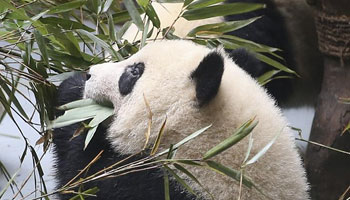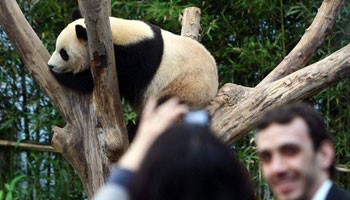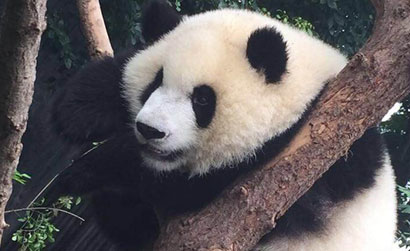1. Where can I see pandas in China besides Sichuan?
The Beijing Zoo Panda House was built in 1989. It is open all year round from 08:30 to 17:00. There are currently about 10 pandas in the Beijing Zoo.
The Shanghai Zoo also has pandas available for viewing. As one of the famous animals of the Shanghai Zoo, the giant panda is the spokesman of the zoo.
The Shanghai Wildlife Park is the largest national wildlife park in China. There are two giant pandas in the Shanghai Wildlife Park.
Guangzhou Zoo is known as one of the three largest city zoos in China, along with Beijing Zoo and Shanghai Zoo. The panda house of Guangzhou Zoo houses two giant pandas.
The panda house in Hangzhou Zoo has been in existence for over 40 years. The panda house was built with a curved glazed tile roof and has a rockery beside it. It looks like a unique flavor of the south of China. It is located in the south of West Lake and integrated with these lush mountains and forests. In addition, you can see pandas in the Hangzhou Wildlife Park.
The Tianjin Zoo and the Tianjin Photosynthetic Valley have two pandas each.
Pandas can also be viewed at zoos in the following cities.
Shijiazhuang Zoo, Hebei
Taiyuan Zoo, Shanxi
Erdos Wildlife Park
Dalian Forest Zoo
Northeast Tiger Park in Jilin Province
Heilongjiang Yabuli Panda Park
Nanjing Red Mountain Forest Zoo
Wuxi Zoo
Jiangsu Dafenggang Zoo
Jiangsu Tianmu Lake Nanshan Bamboo Sea
Jiangsu Yancheng wildlife World
Suzhou Taihu National Wetland Park
Yangzhou Juwan Zoo
Wenzhou Zoo
Ningbo Yagor Wildlife Park
Huzhou Anji Bamboo Park
Hefei Wildlife Zoo
Huangshan Xuning Giant Panda Ecological Park
Fuzhou Panda World Park
Nanchang Zoo
Ganzhou Zoo
Jinan Zoo
Linyi Zoological and Botanical Garden
Zibo Yuanshan Ru Yuehu Wetland Park
Qingdao Zoo
Dezhou Zoological and Botanical Garden
Weifang Jinbao Garden
Weihai Liu Gong Island National Forest Park
Weihai Xixiakou Wild Animal Park
Henan Anyang People's Park
Luoyang Longtan Grand Canyon
Wuhan Zoo
Changsha Ecological Garden
Guangzhou Changlong Wildlife World
Shenzhen Wildlife Zoo
Guangxi Liuzhou Zoo
Guilin Seven Star Park
Ocean Park, Hong Kong
Macau Shek Pai Wan Country Park
Chongqing Zoo
Yunnan Wildlife Zoo
Guizhou Forest Safari Park
Qinling Wildlife Park
Foping Panda Valley
Lanzhou Zoo
2. Where can I see pandas in Sichuan?
Chengdu Giant Panda Breeding Research Base was established in 1987, 10 kilometers from downtown Chengdu. It has now become one of the major bases in China for the relocation and protection of rare and endangered wild animals such as giant pandas. Based on the six pandas rescued from the wild at the beginning of its establishment, the base has successfully increased the captive population of giant pandas to about 70. There are currently more than 100 pandas at the Giant Panda Base.
Panda Valley was completed in 2011 and was equipped for the release of giant pandas for wildlife training research. The first batch of wildlife training pandas entered the valley in January 2012. After the reintroduction training, the pandas will be evaluated for their suitability to be released back into nature. Many pandas have already come to participate in the rewilding transition training. Some of the pandas had returned to their homes after receiving systematic education here.
Dujiangyan Panda Park is located 18 kilometers away from the city, close to the World Heritage Area of Giant Panda Habitat, and has a suitable climate and natural environment for giant pandas to live.
Hetaoping Base was built in the 1980s and was the earliest research base for the breeding and raising of giant pandas by the China Giant Panda Conservation and Research Center. From the time it was put into use to the beginning of the 21st century, Hetaoping Base was mainly responsible for the wild training of captive giant pandas and the breeding and raising of captive giant pandas and their companion animals.
China Conservation Giant Panda Research Center Ya'an Bifengxia Base is located in Ya'an City, Sichuan Province, about 150 kilometers from Chengdu. It takes only 1 hour and 30 minutes from Chengdu Shuangliu International Airport to the giant panda breeding base. The air, water quality, and other natural ecological conditions here are very superior. As of 2012, there are more than 300 wild pandas living in Ya'an and more than 70 captive pandas living happily in Bifengxia Base.
The Chengdu Zoo Panda House is located in the center of Chengdu and now houses and exhibits four giant pandas. This house covers an area of about 1,000 square meters and consists of three outdoor playgrounds, four air-conditioned exhibition halls, several inner rooms, and operation rooms. The house simulates the ecological environment of the habitat of giant pandas and is surrounded by a variety of bamboo species such as mallow bamboo, ginseng bamboo, Guanyin bamboo, Luo Han bamboo, and Ci bamboo, etc. Now it houses two kinds of animals: giant pandas and red pandas.
3. Are pandas dangerous?
People think of the panda as a lazy, cute creature. It has lived on earth for 8 million years and is known as a living fossil. Perhaps the environment is affecting their survival needs, they have now become a dull look that eats and drinks all day long, but what is their fighting ability? Don't take pandas not bears. Their real battle power is beyond your imagination. Don't look at it all day long, it can catch bamboo rats, kill farmers' goats, and attack people causing serious injuries. According to records, the giant panda fought with three jackals and ended up using its amazing tactics to win against the jackals by one against three. This shows that the giant panda is not as weak as it seems.
Sima Qian recorded in Shiji that 4,000 years ago, the Yellow Emperor defeated the Yan Emperor by using domesticated tigers, leopards, bears, pandas, and other fierce animals to help him in battle. During the Spring and Autumn and Warring States period, it was recorded in "Classic of Mountains and Seas" that it resembled a bear and had black and white fur, and was said to eat iron, so it was also called the iron-eating beast. In the Western Jin Dynasty, it already ate only bamboo and did not hunt other animals, plus it looked cute and became a righteous beast, a symbol of peace and friendship. When two armies are at war, as long as one side raises the banner of "panda", both sides will stop fighting and make peace.
Giant pandas can also bite, and there is no doubt that adult pandas are aggressive. The bite force is second only to the polar bear and is on par with the brown bear. The fastest speed at which a giant panda can run is up to 40 kilometers per hour. However, there have been records of pandas moving through the mountains and forests at speeds of up to 50 kilometers per hour when in danger. The average speed of a giant panda walking long distances is slower, only 5-10 kilometers per hour. Although the pandas weigh over 100 kg and look very bulky, they can actually climb trees as high as 20 meters with ease.
So, all in all, the giant panda is a creature whose appearance is completely different from its reality. Don't look at it cute and cuddly, pandas are still only suitable for viewing from a distance.
4. What do pandas eat?
Giant pandas mainly eat bamboo. Ninety-nine percent of the food of giant pandas is bamboo, and there are more than 60 kinds of bamboo plants available for giant pandas to eat. There are many types of bamboo that pandas like to eat, and arrow bamboo is one of the more common species. The recipes of giant pandas vary according to mountain systems and seasons, and they eat different kinds of bamboo or different parts of the same kind of bamboo in different seasons. Different kinds of bamboo shoots are most popular in spring and summer, while bamboo leaves are mostly eaten in autumn and bamboo stalks in winter. Giant pandas eat a lot of food, about 20 kg of bamboo per day. They absorb nutrients from a large amount of fiber. Because they have to digest a large amount of fiber and lignin every day, it is particularly fond of water. The giant panda also retains the simpler digestive tract of a carnivore, without the complex stomach and huge appendix dedicated to food storage that herbivores have. Pandas also do not have symbiotic bacteria or ciliates in their gut to ferment cellulose from plants into absorbable nutrients. The only way to get the nutrients for them is to eat and poop quickly. In order to maintain metabolic balance, an adult giant panda weighing 100 kg has to spend 12 to 16 hours a day eating 10 to 18 kg of bamboo leaves and stalks, or 30 to 38 kg of fresh bamboo shoots, while excreting more than 10 kg of feces. Of course, giant pandas occasionally eat other small animals, such as bamboo rats. When they see them, the panda will slap them to death and have a nice meal. The life of a giant panda is not only eating, but also sleeping. When it wakes up, it starts eating again.
5. What is the best time to see an active giant panda?
If you want to see an active giant panda, it is best to arrive at 9 am. If you can't make it, simply wait until 3 pm and then go in. After eating, pandas spend most of the remaining time sleeping. Giant pandas sleep for 2 to 4 hours in between every two feedings. Lying flat, on their sides, prone, stretched, or curled up in a ball are their preferred ways of sleeping. Inside the zoo, keepers feed them regularly twice a day. So pandas spend the rest of their time resting. Even when they are sleeping, pandas look cute. They are very flexible and can put their bulky bodies into a variety of positions. Their favorite position is with their legs propped up on a tree and their hands covering their eyes. Feeding times for captive pandas are usually between 8-9 am and 3-4 pm.
6. What is the Panda Volunteer Program?
After successfully putting on the panda volunteer overalls, you will officially become a panda volunteer. To become a qualified volunteer, learning to clean the enclosure is the first step. Walking into the pandas' homes, you will pick up brooms to clean their house and replace them with new bamboo. Seeing them leisurely walking around in your clean enclosure is also full of accomplishment.
As a volunteer, panda food cannot be ignored. You will be guided by the base staff to make elaborate panda meals for them. From weighing the ingredients to making the meal, from selecting carrots and apples to matching the meals of the pandas, hand-feeding the panda's food into the mouths of the pandas, and watching them finish eating and waiting for food, your heart will melt. In addition to cleaning the panda enclosures and living areas, preparing food, and feeding them, you can also take a free tour of the park and discuss research on panda habits and physical conditions with the teachers who keep them.
After spending time with the pandas, I believe you must have formed a deep bond with them. At the end of the program, you will receive a volunteer certificate from the China Conservation and Research Center for Giant Pandas, giving official proof of this wonderful memory.
7. Can I adopt a giant panda?
The Qinling Giant Panda Breeding Research Center of the Shaanxi Academy of Forestry Sciences has previously initiated the adoption of baby pandas in the Qinling Mountains. There are three forms of adoption: annual adoption, lifetime adoption, and title adoption. The minimum adoption time for annual adoption is one year, and the annual adoption fee is 100,000 yuan. Lifetime adoption costs 500,000 yuan, which is a direct one-time lifetime adoption but cannot be used for advertising or other purposes. A title adoption costs 1 million yuan, which is a lifetime adoption with a naming right to the panda.
The Chengdu Research Base of Giant Panda Breeding is also accepting adoptions of pandas. They will best express and implement your donation and love into each specific conservation action through naming and adoption, funding scientific research projects, sponsoring scientific activities, and carrying out publicity activities, etc., and will accept the supervision of you and the society at any time. After you adopt, your adoption information will be published on the official website.












